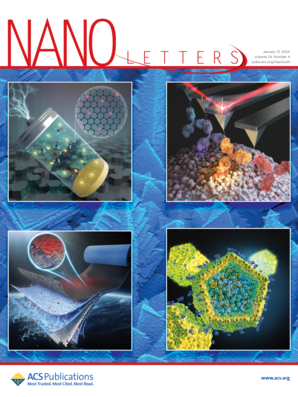Pre-Embedded Potassium Acetate-Modified SnO2 Electron Transfer Layer for Efficient and Durable Perovskite Solar Cells
IF 9.6
1区 材料科学
Q1 CHEMISTRY, MULTIDISCIPLINARY
引用次数: 0
Abstract
Perovskite solar cells (PSCs) have garnered significant attention due to their exceptional photovoltaic performances. However, their power conversion efficiency and stability are significantly hindered by lattice defects and nonradiative recombination losses at the interface between the perovskite film and electron transport layer (ETL). Herein, we report the incorporation of multifunctional potassium acetate (KAc) into SnO2 ETL. Through thermal diffusion of K+ and CH3COO– during annealing, these ions electrostatically penetrate the surface and grain boundary, effectively passivating the formation of bulk defects. The resulting KAc-SnO2 ETL exhibited uniformity, low defect density, and high conductivity, providing an ideal ETL film for the subsequent deposition of perovskite films, thereby enhancing interfacial charge transfer and device efficiency. The optimized device achieved a PCE of 21.76%, a 14% increase over the control device (19.16%), and retained 88.9% of its initial PCE after 1000 h, offering a promising approach for scalable manufacturing in the perovskite industry.

预嵌入醋酸钾修饰的SnO2电子传递层用于高效耐用的钙钛矿太阳能电池
钙钛矿太阳能电池(PSCs)因其优异的光伏性能而备受关注。然而,钙钛矿薄膜与电子传输层(ETL)界面处的晶格缺陷和非辐射复合损失严重阻碍了它们的功率转换效率和稳定性。本文报道了将多功能醋酸钾(KAc)掺入SnO2 ETL中。通过K+和CH3COO -在退火过程中的热扩散,这些离子静电穿透表面和晶界,有效地钝化了体缺陷的形成。所得的KAc-SnO2 ETL具有均匀性、低缺陷密度和高导电性,为后续钙钛矿膜的沉积提供了理想的ETL膜,从而提高了界面电荷转移和器件效率。优化后的装置的PCE达到21.76%,比控制装置(19.16%)提高了14%,并且在1000小时后保持了其初始PCE的88.9%,为钙钛矿行业的可扩展制造提供了一种有前途的方法。
本文章由计算机程序翻译,如有差异,请以英文原文为准。
求助全文
约1分钟内获得全文
求助全文
来源期刊

Nano Letters
工程技术-材料科学:综合
CiteScore
16.80
自引率
2.80%
发文量
1182
审稿时长
1.4 months
期刊介绍:
Nano Letters serves as a dynamic platform for promptly disseminating original results in fundamental, applied, and emerging research across all facets of nanoscience and nanotechnology. A pivotal criterion for inclusion within Nano Letters is the convergence of at least two different areas or disciplines, ensuring a rich interdisciplinary scope. The journal is dedicated to fostering exploration in diverse areas, including:
- Experimental and theoretical findings on physical, chemical, and biological phenomena at the nanoscale
- Synthesis, characterization, and processing of organic, inorganic, polymer, and hybrid nanomaterials through physical, chemical, and biological methodologies
- Modeling and simulation of synthetic, assembly, and interaction processes
- Realization of integrated nanostructures and nano-engineered devices exhibiting advanced performance
- Applications of nanoscale materials in living and environmental systems
Nano Letters is committed to advancing and showcasing groundbreaking research that intersects various domains, fostering innovation and collaboration in the ever-evolving field of nanoscience and nanotechnology.
 求助内容:
求助内容: 应助结果提醒方式:
应助结果提醒方式:


